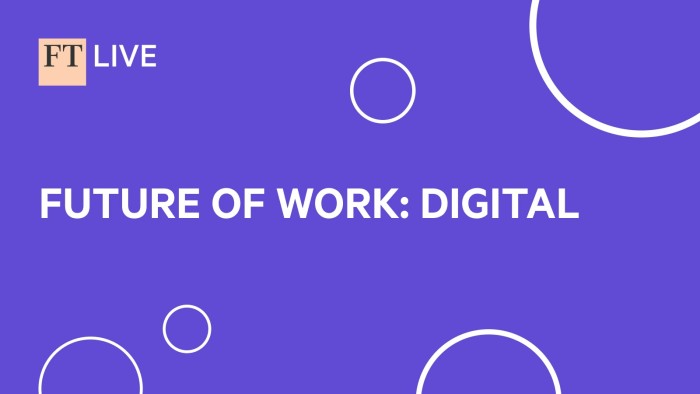Forget the ‘she-cession’ — women will redefine the labour market


Roula Khalaf, Editor of the FT, selects her favourite stories in this weekly newsletter.
Are we moving towards the feminisation of work? And could this lead to a more balanced workplace and economy? I believe the answer to both of these questions is yes.
The idea seems antithetical in the face of the “she-cession,” in which women dropped out of the workforce during the pandemic at higher rates than men in order to buffer a sudden loss of childcare and shoulder the burdens of home-schooling.
But I think this is a coronavirus-related blip that will correct as schools reopen and life returns to some semblance of normal. Most women have to work, economically. In the US, it’s nearly impossible to support a family on the median income of $67,521 if they don’t. Many, of course, simply want to.
The bigger trend is that over the coming years, women will also dominate and redefine much of the labour market.
Consider that female students now represent 59.5 per cent of all college attendees. That trend has been brewing for some time, but it received a big tailwind from Covid-19. While many mothers stayed at home with children, more men dropped out of college than women, in part to support families. In a few years, those college-educated women will have a leg up in the job market.
What about women without degrees? If they don’t return to work, it would be a hit to economic growth, which is a function of the number of workers plus their productivity. But as schools start back up, it’s likely that they will. Consider the example of countries such as France, which kept schools open and had far less female workforce attrition.
Autumn jobs numbers in the US will be telling on this front. But whatever the monthly figures show, there is another reason to believe that the workforce will become more female in the future. Many of the fastest-growing US job categories for the next decade are in the care economy, where women are disproportionately represented.
That part of the economy offers some fascinating examples of how industries can shift when there are more women in the workforce. An upcoming book by Harvard professor Claudia Goldin, Career and Family: Women’s Century-Long Journey Toward Equity, looks at how women have struggled to balance work and home over the decades. Among its many takeaways is the notion that female participation in the workplace changes the very nature of work.
As women became doctors in greater numbers, for example, opportunities for flexible work in the field increased for everyone. A rise in the number of female veterinarians changed the entire structure of the industry, which began to consolidate, since women typically didn’t want the 24-7 schedule that tends to go with individually owned practices.
While the pandemic hit working parents hard, it also prompted a much needed rethink about work-life balance. Why are so many of us burnt out? Must labour markets in rich countries be shaped like a barbell, with too many jobs at the top and bottom and not enough in the middle? Can we all find a better balance? Wouldn’t it be better economically and politically if we did?
Already, there are signs of change. Most large corporations are moving to a permanent flex schedule. Seventy per cent of employees believe this will increase diversity in hiring, according to a McKinsey survey. Cuts in long-haul business travel will make it easier for working parents to take on the big corporate jobs. Companies are even going so far as to prioritise the “meaning” of work. Just look at the investment banks automating more menial tasks, not only to save money but also to attract better talent by offering higher quality work for humans.
Certainly, there are plenty of counter-indicators. Inequality continues to divide the labour market in ways that encourage more extreme hours, an outcome which typically does not favour women. At the lower end of the socio-economic spectrum, automated scheduling software has created a new high-tech Taylorism that is brutal for all low-paid workers but particularly hard for working families.
Yet despite all this, I still think the workplace will become more feminised — and perhaps more humanised — because of large-scale technological shifts. After software, artificial intelligence and other cutting edge technologies have disrupted the labour force even more, coding and care will make up much of what’s left in the job market. Even the number of programmers needed will be far fewer, as machines become better at directing themselves. Software, as Netscape founder Marc Andreessen put it, will eat the world.
New FT Live event

FT’s Future of Work event series is back this October. Join Facebook, LinkedIn, AstraZeneca, Nasa, and more as they explore key themes such as omnichannel workplaces, the impact of AI on jobs, privacy and security issues in distributed workforces. To book tickets, visit here
Meanwhile, an ageing population and the need for better education will require more care, teachers, healthcare workers and, of course, child minders for those providing that labour. Elevating the skill sets and pay of those in this “care economy” is one of the top priorities of the Biden White House.
Diversity has, of course, become a key goal of business. But even if companies prioritised only profit, they should be looking to hire more women, given data showing that share performance can be as much as 50 per cent higher when there are greater numbers of female leaders.
With everything but the highest level of human capabilities commoditised in an increasingly digital world, the businesses that thrive will be those with the most educated, empathetic workers. I suspect more of them will be women.
The return to the office
We want to hear from readers about plans for returning to their workplace. Are you under pressure to go back or are you looking forward to seeing colleagues? Tell us about your plans via this survey.
Letters in response to this article:
A dose of realism needed in fight against inequality / From Duncan Brown, Principal Associate, Institute for Employment Studies, London TW10, UK
If I wrote that about men I’d be reprimanded / From Michael Rosettenstein, Sydney, Australia
Comments